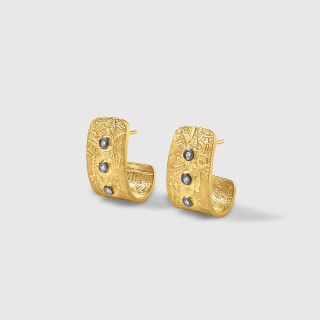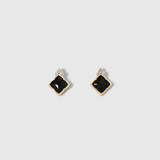A MOUTHPIECE AND A MICROSCOPE
Little in life is as it seems. Tucked comfortably into our respective realities, we perceive all through lenses as unique as fingerprints. We are all composed of the same basic elements and, yet, seldom do we come across a perfect match. Andrea de León is perhaps the most poignant iteration of this truth. She is a befitting combination of nuanced artistry and straightforward physics. And she intends it to be so, answering the random collision of atoms and exchange of energy with her own introspective process. With equal parts force and finesse, she manipulates metal and glass to coerce presence and perspective from a growing audience of admirers around the globe.
“If I inspire or cause someone to think about something in a different way,” smiles de León, “I feel like I’ve fulfilled my purpose. And if my kinetic energy stays within that item and is transferred to someone else — I think it’s the best exchange of energy.”
— Andrea De Leon
De León came from conservative Mexican roots deeply ensconced in traditional “old world” values and rigid social structure. Much like all else, she questioned the confines. Navigating in direct opposition to cultural expectations, she explored art in all its forms. She got her hands dirty, infusing blood, sweat, and the occasional tear in creations defined by unanswered questions, both physical and metaphysical. She found herself entranced with the creative process. “I became addicted to that feeling of losing yourself in your work,” says de León, “when time and space evaporates and you're suspended in a conscious meditative state.” A welcome respite from the chronic bouts of depression and sense of alienation that have colored de León’s life thus far, art became a mouthpiece and a microscope.
Her attraction to the creative was solidified by a high school art class in which young de León first found her stride. Angsty and new to painting, she was both frustrated and intrigued by the emotional space of comprehending something new. “Through the learning curves and the action of making the painting, I realized how therapeutic it was to switch into that ‘flow state,’” describes de León. “I distinctly remember being a completely different person by the time I finished the piece.”
That person went forth to pursue an undergraduate degree in architecture and an “ever-evolving rabbit hole.” Though she was initially inspired by industrial design and its inherent lack of creative confine, de León eventually found the studio arts program at University of Texas and, with it, the hands-on exploration of all things creative — from sculpture and ceramics to foundry and photography. Here, she “digested everything that had to do with process and conceptual design,” developing skill-sets that would become permanent tools in her creative evolution. Delving into the range of artistic pursuits also helped solidify sculpture as her preferred medium and manifestation.
During her undergraduate, she attended various residencies at Ox-Bow School of Arts and Penland School of Craft; both institutions and their respective offerings proved hugely formative. Penland, in particular, was pivotal to de León's life. She had become a reclusive workaholic, obsessed with the process and production. “Art was wreaking havoc on all levels: social, financial, physical,” she remembers. “My health had deteriorated over the years from constant exposure to toxic elements combined with the long hours of work and daily stress.” When she was awarded an extremely competitive work study at Penland, she nearly declined. “At the beginning of the concentration, I was ready to give it up completely, but by the end, I had made the strongest body of work up to that point,” de León recalls. “It completely reinvigorated me and kept me fighting for what I knew I was passionate about, with life lessons learned, of course.”
One of those lessons was to honor her interests. She had always felt a dichotomous mix of right and left brain pursuits; gravitating toward art, while excelling in math and science. But, when she finally examined the schism, she realized it didn’t exist. “Scientific concepts are inherent to art, whether they are obvious or not,” explains de Leon. “Take painting, for example: in color theory, the wavelengths of the electromagnetic spectrum depend on what color is absorbed and what is reflected. They also combine and react differently when adjacent to other colors on the spectrum or when layered on a canvas. Those wavelengths then react with the cones and rods behind the lens of your eye into your optic nerve, sending that information into your brain. Your brain makes sense of those colors on a canvas, making a recognizable image depending on your distinct memories.”
In nearly every form and iteration de León explored, she found similar communion of art and science. In fact, learning the scientific properties of her materials, light, reflection, perception, and a host of other unique factors impacting the creation and viewing of any given work of art opened an entirely new genre of pursuit. “In order to effectively manipulate your material, you have to know its properties,” says de León. “Then you can successfully use those characteristics to distill a language for art.”
Interestingly, that language is as much about the maker as the made, the artist as the audience. It’s not just about the creation. It’s not entirely about the physical forces at play in the making, or the viewing of that creation. And, it’s not completely about the psychology of the creator or the audience. But, it is a synthesis of all of these. Factors ranging from science to culture to materiality to psychosis impact every facet of the physical world. Isolating and exploring one, or several, or all of these factors through the lens of specific metaphysical questions ignites an entirely different sort of artistic fire. It is one of philosophy and place in worlds both personal and cosmic. In this fascinating exploration, there is the opportunity to distill grandiose phenomena into forms and shapes that challenge perception. That redefine art.
“My work tends to be deeply metaphysical,” explains de León. “I make sculpture as a way of externalizing these thoughts and questions. I’m trying to get the audience to discover something they may instinctively already know, but perhaps haven't been recently conscious of. Or bring these ideas to the foreground.” While each piece tends to have some architectural/geometric element, an exploration of mass and void, silver and copper materials, and perspective-challenging optics, they are also uniquely informed by “quantum neurosis,” (the term de León has applied to describe her mindset while creating) an obsessive exploration of physics and philosophy, integrated. “I want you to think about your actual reality,” de León explains. “How photons are passing through your eye — a lens similar to a telescope that observes the universe; how your brain interprets them through electrical signals; how that entire phenomenon is flawed and unique to each human.”
As with life and self, de León’s work is an evolution. Each piece is both deeply personal and emphatically collective, sending forth ripples of shared consciousness and introspection in a world that can always use more. “If I inspire or cause someone to think about something in a different way,” smiles de León, “I feel like I've fulfilled my purpose. And if my kinetic energy stays within that item and is transferred to someone else — I think it's the best exchange of energy.”
Featured Favorites
-

-

Detailed Cicada Pendant Necklace with Diamond Eyes, Sterling Silver
ET-WS-AC-CicadaPendantSterling
$755.00 -

-



 Euro (EUR)
Euro (EUR)
 British Pound (GBP)
British Pound (GBP)








